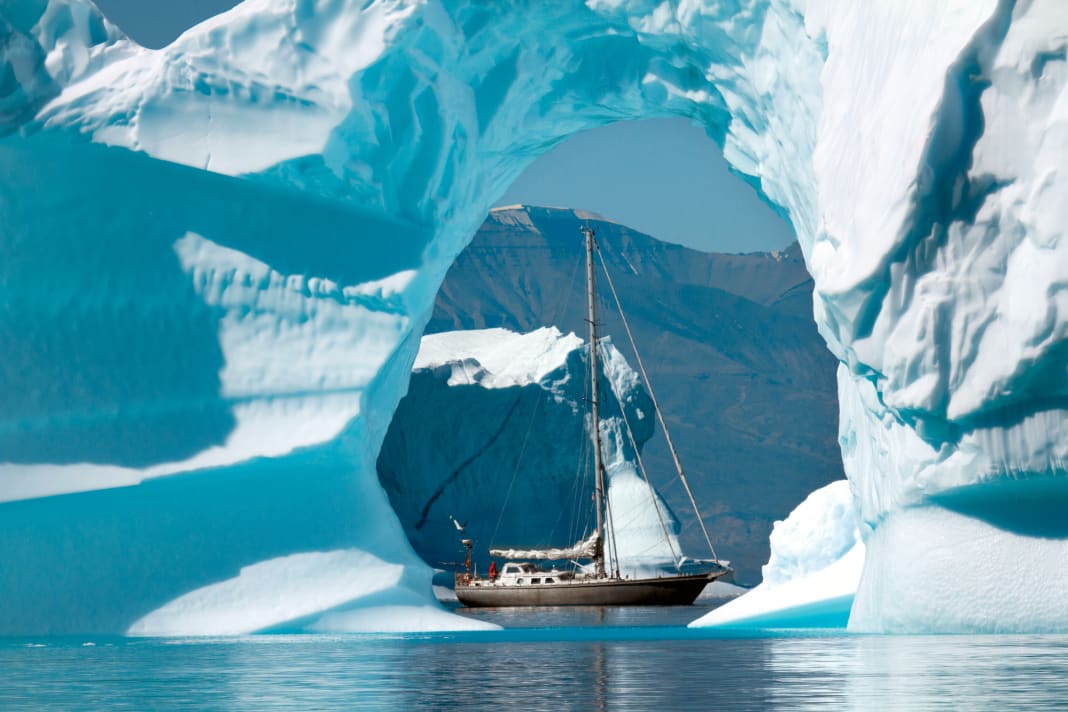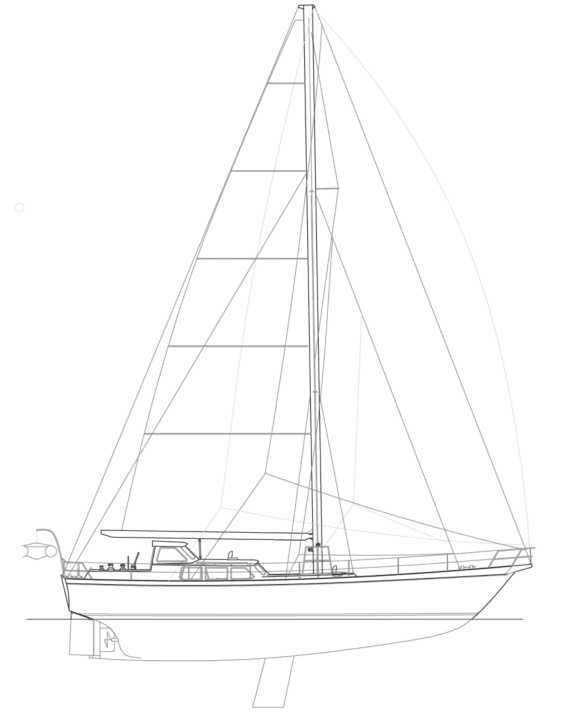





They do exist, these individual constructions where everything comes together as it should, even when the ship is being built. An owner who knows exactly what he wants and is prepared to make the necessary compromises. A designer who understands his craft as well as the owner and puts what is required on paper. And finally, a shipyard that is willing and able to realise the owner's complex wishes to perfection.
When all this comes together, what happens is exactly what the client, Michael Haferkamp from Hamburg, summarises simply: "We were always able to enjoy our trips and never really had to think about the technology or the ship." And that in turn makes the designer and shipyard happy when the project, into which so much heart and soul has been poured, is utilised in an appropriate manner.
This is exactly what the Haferkamps have done: they have used the ship as a platform for their way of travelling. They travelled for twelve years. Spitsbergen was just as much a part of the "Polaris"'s itinerary as the Caribbean and Greenland. They spent the winter there several times. But they were never in a hurry. "In these areas, good planning and plenty of time are simply important. That way you avoid unsafe situations," says Haferkamp.
Consistent concept of the "Polaris"
In the case of the "Polaris", however, this meticulous planning begins long before the lines are cast off for the first time. Always fond of sailing, the Haferkamp family has been travelling on sailing yachts for a long time, most recently on a Hallberg-Rassy 46, and gaining more and more experience in the process. At some point, however, a very long journey is on the cards. Having sold the company, they finally want to go where they would never have thought of going on a normal summer cruise - to the ice.
To achieve this, it had to be a solid, but not overly complicated yacht that was consistently tailored to a crew of two. So Michael Haferkamp set about meticulously planning his ideal yacht: construction, materials, technology and layout. The key points: "Insulation, heating, good anchoring gear, simple operation, redundancy and space for kayaks, skis and other outdoor equipment." All of this requires a lot of space: the insulation made of Armaflex panels, which is often over ten centimetres thick, the huge tanks with a capacity of 2700 litres for the fuel for the engine and heaters alone, the anchor locker with 110 metres of chain and two 300-metre shore lines on rollers. Despite its 17 metres, there is not much more space inside than on a 45-footer.
However, this fits in with the concept: in addition to the double bed in the owner's cabin in the foredeck, the "Polaris" only has two other fixed berths. These are located on the port side next to the lower navigation table, which is used specifically for communication tasks, in a pilot or skipper's cabin. This is perfectly adequate for a crew of two.
Meticulous attention to detail
Incidentally, the other control station is further up, closer to the cockpit. This is where navigation takes place and where the ship's nerve centre is located, ideal for long distances at sea. Haferkamp can give his thoughts on everything on board, everything has been thought through almost pedantically. The shore lines in the anchor locker, for example, are made of Dyneema. Although they are more expensive, they can be thinner, lighter and much longer. This makes them easier to deploy with the dinghy.
Further details: The centreboard, which can be lowered from the long keel, is operated hydraulically. Of course there is a hand pump in case the electric one fails. So far, so normal. However, there is also the option of retracting the centreboard using a chain hoist if all other options fail. It almost goes without saying that the position of the hydraulic cylinder indicates the current depth of the movable attachment, even without any technology. Simple and effective.
The labelling in general. Everything, absolutely everything is labelled. This explains simply and clearly what each switch or lever is for and how it has to be positioned in which operating state. This prevents operating errors. And if things have to be done quickly, there's no need to spend ages searching through operating instructions. There was "little stress on the road. That's one of the reasons," assures the owner. Another example of the meticulousness is the fuel system. An electric pump feeds the diesel from the four tanks distributed throughout the ship into the day tank. This is filtered and the water is removed. The pump is controlled by sensors. It can also be started manually by pressing a button. If this is no longer possible, there is also a hand pump so that clean fuel is always available for the engine and heaters.
Almost as much battery capacity as in a Tesla
Heaters? Yes, there are three. A hot water heater with radiators throughout the ship, a 3500-watt hot air unit and a Refleks stove in the saloon. "This meant we could spend the winter in comfort, even when it was minus 30 degrees Celsius outside. Inside it was 22 plus," says Haferkamp. Hot water is provided either by the main engine or the hot water heater.
Keyword main engine: There is no generator, electricity comes mainly from a second alternator and a wind generator. At sea, a trolling generator also helps. Solar cells? Not a thing. "They're not much use if it doesn't get light during the day," says the owner.
"But we didn't need much electricity either. The Refleks works without any, light came from LEDs and we cooked with paraffin." Nevertheless, the battery banks are enormous. After the refit in 2019, there will be around 5000 ampere hours of lithium batteries in the ship. "That's almost a Tesla battery," explains Tjerk Hutting. He is the head of the shipyard in Makkum, which built "Polaris" at the time and has now overhauled it. The Perkins diesel must therefore not only provide propulsion, but also electricity, so it is better if it always works reliably.
In addition to fuel, it needs cooling. This is provided by a large-area doubling in the hull, which serves as a heat exchanger. This does not even require an impeller pump; the external seawater cooling circuit is not needed at all. The exhaust remains dry, so frost cannot harm the system. The same applies to the shaft seal, where a simple grease packing is also the first choice. It is therefore only logical that the propeller is also particularly robust. With a diameter of almost 60 centimetres and fixed blades, light ice cannot harm it. "Rotary blade solutions seemed too fragile to us. To ensure that nothing rotates under sail, we used a shaft brake similar to a lorry design. This usually works with air, but the one on board here is hydraulic. It engages when the gearbox has no oil pressure, i.e. when the engine is switched off," explains the owner.
Redundancy is essential on "Polaris"
The fact that he attaches great importance to redundancy is also demonstrated by the fact that all the essential parts of the engine are carried on board as welded-in spare parts - right down to the complete injection pump. In the bilge, also shrink-wrapped, an anchor windlass awaits its first use alongside several hundred kilograms of other things that could break.
In the far north, you have to be able to help yourself; there is simply no such thing as a sea rescue service like the DGzRS. "They have a helicopter for the whole of Greenland, so you can't count on help if something goes wrong." And eventually something does go wrong. The ship supposedly winters safely in the harbour of Aasiaat on the west coast of Greenland. In a storm, the steel yacht of a French single-handed sailor breaks free and drifts against the "Polaris". A large dent appears on the starboard side, roughly midships. But the aluminium hull does what it should and remains tight. The rigging also escaped without damage. No wonder: the hull is made of 7 millimetre thick Sealium above the waterline and 8 millimetres below.
Sealium is a special aluminium alloy which, compared to normal aluminium, is particularly resistant to seawater and is also stronger. The keel area of the hull is even 20 millimetres thick. Areas such as around the rudder, skeg and propeller are further reinforced. "We don't have an ice class, but even when large blocks of ice hit the hull, they never left any marks," reports Haferkamp.
Speaking of leaving traces: The interior, the shipyard boss assures us, was not touched during the refit - "everything is still original, as it came from the shipyard back then. We didn't even repaint the floors." That's astonishing, because the use, including wintering on board, was quite intensive. You can't tell by looking at the ship.
Sailing characteristics of the "Polaris
So how does such a monster sail? 28 tonnes and 140 square metres on the wind mean a sail load factor of 3.9, which is manageable. 10.8 tonnes of ballast are inside the hull. The long keel provides a lot of resistance under water. "Well, it's a passage maker," explains shipyard boss Hutting, as if to say that sailing characteristics were not the top priority. And perhaps they weren't. Cruising free from a lee shore? You can, thanks in part to the centreboard, which can be lowered up to 3.20 metres. And apart from that, you're in no hurry on and with the "Polaris".
The time on board under sail is simply pleasant, so it doesn't matter if an Atlantic passage takes a day or two longer. However, due to the length of the waterline, average speeds are good and distances of 200 nautical miles are possible. Whether in the deck saloon on the couch with a panoramic view of the navigation table or under the dodger in the cockpit: a watch can be worked off comfortably. Cooking is also excellent in the large central galley; it doesn't get much more seaworthy than this. The toilet room right by the companionway also helps if you need to go to the toilet on watch. And the bunk in the foredeck is perfect for a restful night's sleep away from the ship's command during free time. If things get really bumpy, the pilot's berth amidships is available.
The steering is even reasonably direct and communicative, although the sailor does not usually take the helm himself, but lets one of the two independent autopilots do the work. The sailing experience was also consistently focussed on the actual task of the boat: comfortable and safe cruising. The last bit of light wind performance has to take second place.
The Haferkamp family's trips to the far north are over. "Even though I can never get enough of ice cream. There, surrounded by nature, we simply had the feeling that we had arrived. It's hard to talk about this nature, you have to experience it." And that works particularly well on board the "Polaris". She is currently waiting for a new owner and new adventures.
Technical data of the "Polaris"

- Torso length: 17,20 m
- Width: 4,65 m
- Depth: 1,50-3,20 m
- Displacement: 28,0 t
- sail area: 140,0 m²
- Ballast: 10,8 t
- Material: Aluminium/Sealium
- Shipyard: Hutting Yachts Makkum
- Designer: Dick Koopmans
This article appeared in YACHT issue 20/2020 and has been revised for the online version.
Other special boats:
- "Betty Blue": Transformation of a dinghy cruiser into a piece of jewellery
- Whitbread racer "Maiden": Women on a circumnavigation with a mission
- 75-series warping cruiser: "Gun" enriches the classic scene on Lake Constance
- "Linea": Elegant self-build using a special method
- "Hans Uhl": Regatta-capable regent for several generations

